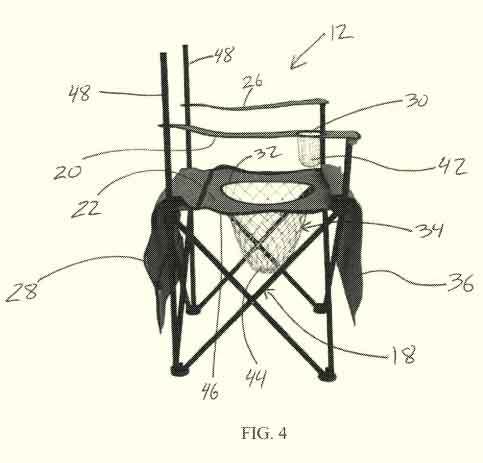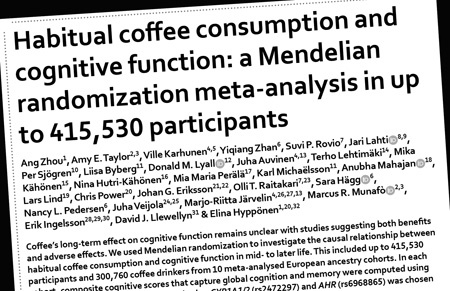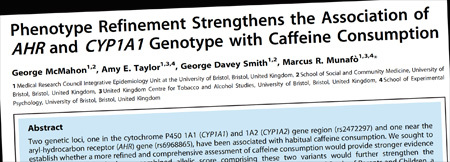Marc Abrahams's Blog, page 186
May 19, 2018
Alternate histories of the universe
There are many alternate histories of the universe. Here are two.
A Briefer History of the Universe
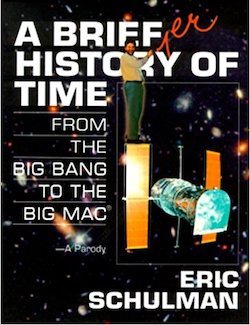 Eric Schulman’s 60-second-long History of the Universe began as a print piece (“A History of the Universe in 200 Words or Less,” in the Jan/Feb 1997 issue of the Annals of Improbable Research), had its first public performance as part of the 1997 Ig Nobel Prize ceremony, was expanded into book form (a publisher, in the audience that night, solicited Schulman on the spot to write it), and has been performed many times.
Eric Schulman’s 60-second-long History of the Universe began as a print piece (“A History of the Universe in 200 Words or Less,” in the Jan/Feb 1997 issue of the Annals of Improbable Research), had its first public performance as part of the 1997 Ig Nobel Prize ceremony, was expanded into book form (a publisher, in the audience that night, solicited Schulman on the spot to write it), and has been performed many times.
The original 200-word version was eventually translated into many languages, by volunteers on various parts of the planet Earth. Much of that Universal History Translation Project survives, still, on the Internet Archive.
You can see video of a special performance at the National Science Foundation:
A Dominoic History of the Universe
Recently, the Scope of Science web site created a more expanded history of the universe, involving dominoes. Here’s video of that (thanks to Scott Langill for bringing it to our attention):

May 18, 2018
Plain-words challenge: Wedding Words
Today’s challenge is to translate a paragraph into clear language that anyone can understand. This paragraph appears in the study “Consumption as common sense: Heteronormative hegemony and white wedding desire,” by Patricia Arend [pictured here], published in the journal Journal of Consumer Culture [vol. 16, no. 1, 2016, pp. 144-163]:
 “[This] article examines the white wedding desires of women who experience them as common sense. I use Ludwig’s concept of heteronormative hegemony to provide a more thorough account of both gendered subject formation and white wedding desire. In this analysis, women’s social consumption of mass media, embodiment of gendered habitus as taste and ritualized conversations with other women are particularly salient.”
“[This] article examines the white wedding desires of women who experience them as common sense. I use Ludwig’s concept of heteronormative hegemony to provide a more thorough account of both gendered subject formation and white wedding desire. In this analysis, women’s social consumption of mass media, embodiment of gendered habitus as taste and ritualized conversations with other women are particularly salient.”

Portrait of a Self-Recognized Genius: Jordan B. Peterson
Jordan B. Peterson, one of the world’s great self-recognized geniuses, gets a warm appreciation in The New York Times. Nellie Bowles writes:
Mr. Peterson, 55, a University of Toronto psychology professor turned YouTube philosopher turned mystical father figure, has emerged as an influential thought leader….
[He says] the “radical left” wants to eliminate hierarchies, which he says are the natural order of the world. In his book he illustrates this idea with the social behavior of lobsters. He chose lobsters because they have hierarchies and are a very ancient species, and are also invertebrates with serotonin. This lobster hierarchy has become a rallying cry for his fans; they put images of the crustacean on T-shirts and mugs.
Professor Peterson boiled down his thoughts about lobsters. The boiled mass is served up in Professor Peterson’s paper called “The Functional Neuroanatomy and Psychopharmacology of Predatory and Defensive Aggression.”
BONUS (possibly unrelated): The 2016 Ig Nobel Prize for psychology was awarded to Gordon Pennycook, James Allan Cheyne, Nathaniel Barr, Derek Koehler, and Jonathan Fugelsang for their scholarly study called “On the Reception and Detection of Pseudo-Profound Bullshit” [published in the journal Judgment and Decision Making, vol. 10, no. 6, November 2015, pp. 549–563].

The Benefit, for Bedbugs, of Dirty Laundry
Bedbugs in search of cheap travel options would be well-advised to consider humans’ dirty laundry, suggests a reading of this study:
“Bed Bug Aggregation on Dirty Laundry: A Mechanism for Passive Dispersal,” William T. Hentley, Ben Webster, Sophie E.F. Evison, and Michael T. Siva-Jothy, Scientific Reports, vol. 7, no. 11668, 2017. The authors, at the University of Sheffield, UK, report:
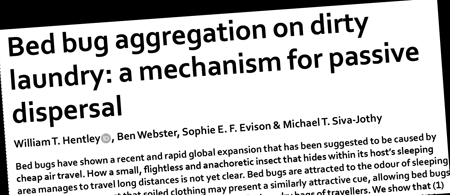
“Bed bugs have shown a recent and rapid global expansion that has been suggested to be caused by cheap air travel. How a small, fightless and anachoretic insect that hides within its host’s sleeping area manages to travel long distances is not yet clear. Bed bugs are attracted to the odour of sleeping humans and we suggest that soiled clothing may present a similarly attractive cue, allowing bed bugs to ‘hitch-hike’ around the world after aggregating in the laundry bags of travellers. We show that (1) soiled clothing is signifcantly more attractive than clean clothing to active bed bugs moving within a bedroom sized arena and (2) elevation of CO2 to a level that simulates human occupancy in the same arena appears to initiate search behaviour rather than direct it. Our results show, for the frst time, how leaving worn clothing exposed in sleeping areas when travelling can be exploited by bed bugs to facilitate passive dispersal.”
BONUS BOOK: Infested: How the Bed Bug Infiltrated Our Bedrooms and Took Over the World

May 17, 2018
The Straight Poop: Sociology of Canadian Donut Shops, Ongoing
The sociology of Canadian donut shops plays out afresh, as described in a New York Post report headlined “Lady poops on restaurant floor, flings it at cashier.” That report includes action video.
The 1999 Ig Nobel Prize for sociology was awarded to Steve Penfold, of York University in Toronto, for doing his PhD thesis on the sociology of Canadian donut shops. Penfold’s dissertation is: “The social life of donuts: Commodity and community in postwar Canada.” He later expanded it into book form: The Donut – A Canadian History, University of Toronto Press, Scholarly Publishing Division, 2008. Penfield is now a professor at the University of Toronto.

Could this new, chair-based invention “Make America Fun Again” ?
This device has just received a US patent (April 24, 2018) – can you guess its function?
It’s not only a (semi) conventional fold-up chair – it’s also the basis of a number of tailgating, beach, BBQ and Family Games.
“The present disclosure relates to a chair with game features. The chair can function as a conventional folding chair used at outdoor events, and can also function as a game that can be played at such outdoor events. By combining multiple features into one compact package, the chair is space-saving and easily transported. The chair is uniquely designed to provide an enhanced tailgating experience, by providing room to rest, and a gameplay area into a combined package.”
See: US Patent 9,950,230 “Chair with game features”.
Here is an explanatory video from the inventors, whose declared (singular) goal is to “Make America fun again!”

May 16, 2018
Many People Look at Many Other Looks at Other People Who May Have Been Drinking Coffee and Thinking
The mystery of whether drinking coffee affects people’s minds is still mysterious, thanks to the results of a new, complex academic study of many old, complex academic studies:
“Habitual coffee consumption and cognitive function: a Mendelian randomization meta-analysis in up to 415,530 participants,” Ang Zhou, Amy E. Taylor, Ville Karhunen, et al., Scientific Reports, epub 2018. The large team (28 co-authors) reports:
“Coffee’s long-term effect on cognitive function remains unclear with studies suggesting both benefits and adverse effects. We used Mendelian randomization to investigate the causal relationship between habitual coffee consumption and cognitive function in mid- to later life. This included up to 415,530 participants and 300,760 coffee drinkers from 10 meta-analysed European ancestry cohorts. In each cohort, composite cognitive scores that capture global cognition and memory were computed using available tests.”
The people considered to have been drinking coffee may not all have been drinking coffee. The study explains:
“A genetic score derived using CYP1A1/2 (rs2472297) and AHR (rs6968865) was chosen as a proxy for habitual coffee consumption…. Despite the power to detect very small effects, our meta-analysis provided no evidence for causal long-term effects of habitual coffee consumption on global cognition or memory.”
Were the Coffee-Drinkers Coffee-Drinkers?
Part of the same team of researchers did an earlier study on the very question of whether many people thought to have been drinking coffee may have been drinking coffee. They concluded that yes, many people thought to have been drinking coffee may have been drinking coffee. That study is:
“Phenotype refinement strengthens the association of AHR and CYP1A1 genotype with caffeine consumption,” George McMahon, Amy E. Taylor, George Davey Smith, and Marcus R. Munafo, PloS One, vol. 9, no. 7, 2014, e103448. The authors report:
“Two genetic loci, one in the cytochrome P450 1A1 (CYP1A1) and 1A2 (CYP1A2) gene region (rs2472297) and one near the aryl-hydrocarbon receptor (AHR) gene (rs6968865), have been associated with habitual caffeine consumption…. We used data from between 4,460 and 7,520 women in the Avon Longitudinal Study of Parents and Children, a longitudinal birth cohort based in the United Kingdom. Self-report data on coffee, tea and cola consumption (including consumption of decaffeinated drinks) were available at multiple time points. Both genotypes were individually associated with total caffeine consumption, and with coffee and tea consumption.”

Using big words to argue that you are right and other people are wrong
If you believe that science is all about using big words to argue that you are right and other people are wrong, here’s an article that uses big words to argue that you are right and other people are wrong:
“The Role of Science in Evangelical Hermeneutics,” John B. King Jr., Theology and Science, epub 2018. The author explains:

In this article, I argue that evangelical Christians can accommodate science within the limits of strict Biblical exegesis governed by grammatical-historical hermeneutics. To this end, I describe the grammatical-historical method to show how science enters into it. I then distinguish between theological and exegetical uses of science. Next, I use Lakatos’ philosophy of science to distinguish between ad hoc and well-motivated exegetical moves. Based upon these criteria, I then present the gap- and day-age theories as examples of hermeneutical failure in the accommodation of science. Finally, I use the framework interpretation to illustrate a hermeneutically successful accommodation of science.
The paper explains that its author
is an Independent Scholar and freelance writer. He earned a PhD in Mechanical and Nuclear Engineering from Oregon State University as well as a ThD from the Graduate Theological Union and a DMin from George Fox Evangelical Seminary.
BONUS: The 2006 Ig Nobel Prize for literature was awarded to Daniel Oppenheimer for his report “Consequences of Erudite Vernacular Utilized Irrespective of Necessity: Problems with Using Long Words Needlessly.”

May 15, 2018
A butt heads-up—The admiration of readers like Jenn
We bask in the admiration of readers like Jenn, who sent us this butt note. If you have a blog, maybe you receive many notes from readers like Jenn. If you don’t have a blog, maybe you receive many notes from readers like Jenn:
Dear Editor,
My name is Jenn and I’m an Editor at [REDACTED]. I was doing research on butt workouts and just finished reading your wonderful blog post: https://www.improbable.com/2011/03/10/gluteus-maximumus-reminds-docs-of-popeye/
In that article, I noticed that you cited a solid post that I’ve read in the past: https://en.wikipedia.org/wiki/Buttocks
We just published an article that is even more detailed, updated and comprehensive on the 30 most effective butt workouts. It is written by a two-time field hockey Olympian, completely free and includes step-by-step videos, practical tips and advice. You can find it here: [REDACTED]
If you like the article we’d be humbled if you cited us in your article. Of course, we will also share your article with our 50k newsletter subscribers and followers across our social platforms.
Either way, keep up the great work!
Warmly,
Jenn

Women and Men at a British Pedestrian Crossing
Is it daring to cross the street at a designated pedestrian crossing? If so, are women more daring than men—or vice versa? A study explores this question:
“Gender Differences in Use of a Pedestrian Crossing: An Observational Study in Newcastle upon Tyne,” Eryn O’Dowd and Thomas V. Pollet, Letters on Evolutionary Behavioral Science, vol. 9, no.1, 2018. The authors, at Northumbria University, UK, explain:

“Evolutionary psychologists have put forward that there are evolved differences in risk taking between men and women. Potentially, these also play out in every day behaviours, such as in traffic. We hypothesised that (perceived) gender would influence using a pedestrian crossing. In addition, we also explored if a contextual factor, presence of daylight, could modify risk taking behaviour. 558 pedestrians were directly observed and their use of a crossing near a Metro station in a large city in the North East of England was coded. Using logistic regression, we found evidence that women were more inclined than men to use the crossing. We found no evidence for a contextual effect of daylight or an interaction between daylight and gender on use of the crossing. We discuss the limitations and implications of this finding with reference to literature on risk taking.”
This passage in the paper gets at what the authors mean by “risk taking”:
“The entrance to the metro station is to the left of the wooden shoulder. The safe route makes use of the crossing, the risky route is effectively ‘jaywalking’ between the metro entrance and the path.”
(Thanks to Joseph H Lynch for bringing this to our attention.)

Marc Abrahams's Blog
- Marc Abrahams's profile
- 14 followers




